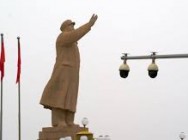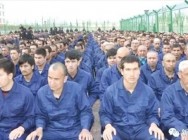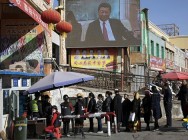Last Minute

- CHINA RELATIONSEAST TURKESTAN PROBLEM AND TURKEY
- FRONTLINE China Undercover
- Elimination of “Uyghur Counter-Revolutionary Officials” in Academic Fields—Exact Quotes Translated from a Mandarin Audio File
- In Push for Trade Deal, Trump Administration Shelves Sanctions Over China’s Crackdown on Uighurs
- Dalai Lama’s 60th Anniversary Symposium: İlshat Hassan speech in English and Chinese
- Uyghur Detainees from Xinjiang ‘Placed in Nearly Every Prison’ in Shandong Province
- Shahrezad Ghayrat, Unrepresented Women
- Uighur Americans Speak Against China’s Internment Camps. Their Relatives Disappear.
- Rozinisa: The true story of the Uyghur girls in the prison
- The Chinese Government Must Account for the Disappearance of the 10+ Million Uyghurs

-

CHINA RELATIONSEAST TURKESTAN PROBLEM AND TURKEY
-

FRONTLINE China Undercover
-

Elimination of “Uyghur Counter-Revolutionary Officials” in Academic Fields—Exact Quotes Translated from a Mandarin Audio File
-

In Push for Trade Deal, Trump Administration Shelves Sanctions Over China’s Crackdown on Uighurs
-

Dalai Lama’s 60th Anniversary Symposium: İlshat Hassan speech in English and Chinese
-

Uyghur Detainees from Xinjiang ‘Placed in Nearly Every Prison’ in Shandong Province
Present-Day Ethnic Problems in Xinjiang Uighur Autonomous Region: Overview and Recommendations (1)
By Ilham Tohti, translated by Cindy Carter, published: April 22, 2015
This article, a total of 24,000 words in Chinese, was first posted on the Daxiong Gonghui (“大象公会”) website after the Uighur scholar Ilham Tohti’s arrest in January, 2014. Daxiong Gonghui described the origin of the article in a note: “This document was written by Ilham Tohti, associate professor of economics at Minzu University of China (formerly Central Nationalities University), in response to a 2011 request from high-level officials in the Chinese government. Ilham Tohti made first-draft revisions to this document in October of 2013, but was unable to complete a final draft.” The post has since been censored and is only available elsewhere as a repost. I was able to confirm the origin and the authenticity of the article with Mr. Huang Zhangjin (黄章晋), the editor of the online Daxiong magazine. The translation will be posted in several installments for easy reading, and the entire article will be ready for download in a few days. – The Editor
Since Zhang Chunxian (张春贤) took office, a big push on Xianjiang policy by the Chinese central government and a series of initiatives by Zhang Chunxian himself have rekindled hope among ethnic population in Xiangjiang for the region’s future social stability and development prospects.[1]Furthermore, Zhang Chunxian has managed, in a very short period of time, to win high praise from local ethnic minority officials and intellectuals alike.
At present, the new administration in Xinjiang is relying on increased economic investment and improvements in citizens’ livelihoods to quell ethnic tensions. These policies will likely have a positive short-term effect, but because they do not address deep-seated problems, we cannot afford to be sanguine about Xinjiang’s future, nor can we be certain that violence will not erupt again. If the government is to win broad-based popular support and achieve genuine long-term peace and stability, it must promote further systemic and social adjustments.
To this end, I have prepared a simple list of nine issues affecting ethnic relations in Xinjiang. For each, I have included an overview of the present situation, causes and contributing factors, and proposed solutions.
I. Unemployment among Ethnic Minorities
Overview
Unemployment is a social issue that affects all regions of China, but Xinjiang’s unemployment problem tends to be concentrated among ethnic minorities. For Uighurs who migrate to the cities in search of work, employment opportunities are markedly limited, confined to a narrow band of service-industry jobs, mostly jobs in restaurants. There is a vast gap in employment opportunities available to different ethnic groups: Uighur and other ethnic-minority job applicants face significant employment discrimination. These factors, in turn, fuel resentment toward the government and toward the Han Chinese majority.
Because the factors driving urban and rural unemployment are so different, we can divide the employment issue in Xinjiang into two distinct facets: (1) unemployment among Uighur university graduates and (2) the rural labor surplus.
- Unemployment among Uighur university graduates
According to official government data, only 17% of ethnic Uighur university students in Xinjiang manage to secure a full-time job by the time they graduate. This is far below the rate for ethnic Han Chinese university students. My own research reveals that the actual job-placement rate for Uighur university students approaching graduation is even lower, at less than 15%. The difficulty of finding work after graduation not only impoverishes ethnic-minority families who have sacrificed to send their children to university, it also contributes to the notion, widespread among Uighurs, that education is useless.
- The rural labor surplus
The rural labor surplus in Xinjiang is a serious problem. The root cause of this excess rural labor force is lagging urbanization and industrialization in Uighur areas. In fact, the actual urbanization rate among the Uighur population is only about 10%.
Most of Xinjiang’s Uighur population is concentrated in the rural south, where the average amount of arable land per capita is less than one mu, or one-sixth of an acre. This sort of marginal existence and inescapable poverty not only bottles up vast reserves of surplus rural labor, it also gives rise to lawlessness and criminal behavior, making these areas potential breeding grounds for future threats to the social order. If this vicious cycle is allowed to continue, it may even bring about the collapse of southern Xinjiang’s fragile oasis ecosystem.
Causes
1. Given the absence or non-enforcement of national ethnic policies, the primary cause of employment difficulties among minority university students is blatant ethnic discrimination in hiring. Ethnic minorities are severely under-recruited for jobs in the civil service and in state-owned enterprises. Prior to the July 2009 ethnic unrest in Urumqi, many private-sector job advertisements openly stated that only Han Chinese applicants would be considered; some state-owned enterprises went so far as to recruit Han Chinese from other parts of mainland China, rather than hire local ethnic minorities. At some workplaces with no Uighur employees, Uighurs may be stopped by security guards and prevented from entering the premises. Severely curtailed employment prospects have given rise to an unusual phenomenon in Xinjiang: a craze for extracurricular foreign language training courses. Xinjiang’s ethnic minority university students are keener on studying foreign languages than students at top-tier universities such as Peking University and Tsinghua University, because these students feel that their only hope lies in finding work in international trade, tourism, or overseas. Even the privileged classes are not immune to employment difficulties: one child of a high-ranking Xinjiang Uighur government official graduated from a prestigious mainland university and spent a year searching fruitlessly for work. It was only after securing a personal letter of introduction from Wang Lequan [then Communist Party Secretary of Xinjiang] that the young graduate was finally able to secure a job.
2. A unique feature of Xinjiang’s natural geography is its desert archipelago of insular, isolated oases. Historically, there has been a vast gap in the amount of government investment given to these different geographical units. This is particularly true of the Uighur enclaves in Xinjiang’s south, where urbanization and industrialization lag far behind the Han Chinese-dominated “Tianshan North Slope Economic Zone.” (The “Tianshan North Slope Economic Zone,” situated at the northern foot of the Tianshan mountain range, is the most economically developed region of Xinjiang. This highly concentrated swath of productive forces forms the developmental core of Xinjiang’s modern industry, agriculture, telecommunications, education, science, information technology and other sectors. Home to over 83% of Xianjiang’s heavy industry and 62% of its light industry, favored with ample natural resources and robust urban and transportation infrastructure, the zone accounts for over 40% of Xinjiang’s gross domestic product.) Xinjiang’s south is geographically isolated; the Han Chinese cities in the north tend to exclude Uighurs; and when the surplus rural labor force in the south tries to flow into the Tianshan North Slope Economic Zone, it is met with restrictions. All these make it even more difficult for southern surplus rural labor to migrate to urban areas.
3. Severe underinvestment in basic education: there is a vast north-south disparity in educational investment in Xinjiang. Even in southern Xinjiang, one finds stark ethnic inequalities in the allocation of educational resources, particularly in the area of secondary schools. Whether in terms of fiscal investment or number of schools, the proportion of educational resources allocated to Uighur students is far below what it should be, given their percentage as a proportion of the local population. Moreover, the high school enrollment rate in southern Xinjiang is extremely low, due to the critical lack of investment in basic education: in large Uighur population centers such as Kuqa country and Shache [Yarkant] county, there is only one high school in each county offering Uighur-language instruction. As a result, average educational levels in Uighur communities in southern Xinjiang are extremely low, causing workers to be inadequately equipped for careers in modern agriculture or industry. The surplus rural labor supply spills into the cities, where migrants face severely limited job prospects, forcing them further afield into the interior to look for better opportunities.
4. Since the ethnic unrest of July 2009, nearly all of Xinjiang’s Uighur enclaves have been subject to the constant pressure of “stability maintenance” policies. Rural migrants to the northern city of Urumqi have been expelled in large numbers, and forced to return to their villages in the south. At the same time, local governments have adopted stringent limits on outward population migration, thus exacerbating the problem of rural employment.
Thoughts and Recommendations
The Uighur unemployment problem is the cumulative result of numerous long-term forces. As such, resolving the dilemma will require a broad-based approach and systematic long-term planning; it will not happen overnight. Simply pouring money from central government coffers into Xinjiang to create a slew of make-work jobs is not the right approach: not only would this prove an undue fiscal burden for the government, it would also transform the Uighur population into a people dependent upon handouts, engendering a sense of shame and inferiority.
I have the following thoughts on how the issue of unemployment should be addressed systematically:
1. Article 23 of the “Regional Ethnic Autonomy Law of the People’s Republic of China” expressly stipulates that ethnic minorities be given priority in hiring by government institutions and state-owned enterprises.[2] Even taking into consideration the practical difficulties of immediately implementing such a policy, steps should be taken to gradually expand Uighur employment opportunities and to phase in quotas for the hiring of ethnic minorities in the civil service and state-owned enterprises. At present, public services in Xinjiang suffer from a serious dearth of Uighur and other ethnic minority employees. Hospitals, post offices, banks, insurance companies, notaries, courts, municipal bureaus and other social service organizations are staffed mainly by Han Chinese who cannot speak Uighur, causing tremendous inconvenience to Uighur citizens in their daily lives.
2. The government should take an active role in promoting internal population migration in Xinjiang as a means of alleviating unemployment in the south and preventing further damage to the fragile southern ecosystem. For example, it could oversee a controlled and systematic transfer of a certain proportion of southern Xinjiang’s population to the northern industrial belt, or to farms managed by the Xinjiang Production and Construction Corps (XPCC). Instead of spending vast sums of labor and capital to organize rural migrant workers to culturally unfamiliar coastal cities thousands of kilometers away, the regional government should encourage rural-to-urban population shifts within Xinjiang’s borders. The Xinjiang Production and Construction Corps (XPCC), currently suffering from severe manpower shortages due to population drain, has tried all manner of methods to attract labor from other areas of mainland China, but it has done nothing to absorb the surplus rural labor force that exists in southern Xinjiang.
By taking an active role in organizing and guiding population shifts within Xinjiang, the government can alleviate unemployment in the south, while also reducing ethnic segregation and helping to dispel the notion, prevalent within the Uighur community, that the XPCC and the northern cities are being used by Han Chinese to deal with the Uighur population.
3. Provide more assistance to ethnic minority entrepreneurs. This is the most fundamental, long-term solution to Xinjiang’s unemployment problem, and it relies on market-based mechanisms rather than governmental supervision. Since Secretary Zhang Chunxian assumed office, there has been a noticeable improvement in Xinjiang’s level of assistance to ethnic minority entrepreneurs. I recommend broadening this approach to establish a long-term plan aimed at improving the modern management skills of ethnic minority entrepreneurs via exchanges with highly developed coastal regions and prestigious mainland Chinese universities, thus creating a long-term mechanism for the systematic training of minority entrepreneurs. Furthermore, we should foster closer cooperation between Han Chinese and ethnic minority entrepreneurs, encouraging them to bond together in their mutual interest. Having the government train and support a large contingent of minority entrepreneurs is the most convenient way to promote ethnic unity and harmony in Xinjiang.
One detail worth noting: the practice of prominently featuring minority entrepreneurs as speakers at government-organized ethnic unity rallies may not have the desired propaganda effect. Minority entrepreneurs should not be leveraged for government publicity: they have a far more important and effective role to play off the political stage.
4. Increase investment in basic education in minority-populated areas. The government has many long years of unfulfilled promises in this regard, but expanding access to basic education will transform minority peoples’ ability to adapt to industrialization and urbanization. In a mere five to ten years, we will begin to see a marked improvement. At the very least, better access to education will significantly reduce the barriers that ethnic minority migrants face when trying to enter the urban labor force. Now that the government has substantially increased investment in basic education in southern Xinjiang, there remain two problems that need to be addressed: countering the preconception that education is useless, and correcting misapprehensions and assuaging people’s fears about bilingual education.
5. Establish systematic professional and technical training for ethnic minority workers. Xinjiang suffers from a serious lack of ethnic minority professional and technical personnel, which makes it difficult for ethnic minorities to enter the technical and industrial workforce. Entrepreneurial skill is also in short supply to start businesses. I propose increasing training for early-career and mid-career specialists in fields suited to the unique economy of the Xinjiang Autonomous Region, in which resource-oriented and state-owned enterprises predominate. For example, the government could work with vocational and technical schools to increase employment opportunities for ethnic minorities in the mining, textile, and agricultural-processing sectors. In fact, work on this has already begun, to positive feedback from Xinjiang’s Uighur community.
I also recommend that the Xinjiang Autonomous Region cooperate with localities in China’s more economically developed coastal regions to systematically train up a cohort of technically-proficient ethnic minority youth who will form Xinjiang’s future technological and entrepreneurial talent pool.
6. Establish brigades of ethnic minority industrial workers. Industrial workers are an essential component and driving force of industrial and economic development. They play a fundamental role in accelerating industrial transformation, promoting technological innovation, improving corporate competitiveness, and so on. Employers in Xinjiang are currently in need of a large number of industrial workers, but they face widespread difficulties in recruiting qualified personnel.
Training up and establishing brigades of ethnic minority industrial workers will help to expand employment opportunities and widen career horizons for minority university and polytechnic graduates. This, in turn, will increase the employment rate among ethnic minorities and help facilitate their adjustment to modern industrial society.
7. Leverage local and regional advantages to support the development of Xinjiang’s own cultural and creative industries. This would both raise employment and allow Xinjiang’s cultural influence to radiate across the Central Asian region. Targeted training and practical support would help creative entrepreneurs and small- and medium-size enterprises to expand into the broader Central Asian market. China’s information technology, animation, advertising and other creative sectors enjoy a distinct advantage in the Central Asia market region, but Han Chinese enterprises attempting to enter this market face tremendous cultural and linguistic barriers, whereas Uighur enterprises possess a natural advantage. By leveraging the technological strength of China’s other regions, it is entirely possible for Xinjiang to cultivate local cultural and creative industries with a strong competitive edge in Central Asia. This would allow Xinjiang’s ethnic minority populations to transform themselves from cultural importers to cultural exporters, an achievement of immeasurable importance.
Translator’s Notes:
[1] In April 2010, Zhang Chunxian was appointed Communist Party Secretary of the Xinjiang Uyghur Autonomous Region, replacing Wang Lequan, whose divisive policies may have helped to fuel ethnic unrest in the region. Zhang Chunxian’s appointment was regarded by many as positive step toward defusing ethnic tensions in Xinjiang.
[2] The English text of Article 23 of the “Regional Ethnic Autonomy Law of the People’s Republic of China” reads: “When recruiting personnel in accordance with state regulations, enterprises and institutions in ethnic autonomous areas give priority to minority nationalities and may enlist them from the population of minority nationalities in rural and pastoral areas.”
http://chinachange.org/2015/04/22/present-day-ethnic-problems-in-xinjiang-uighur-autonomous-region-overview-and-recommendations-1/
RELATED NEWS












